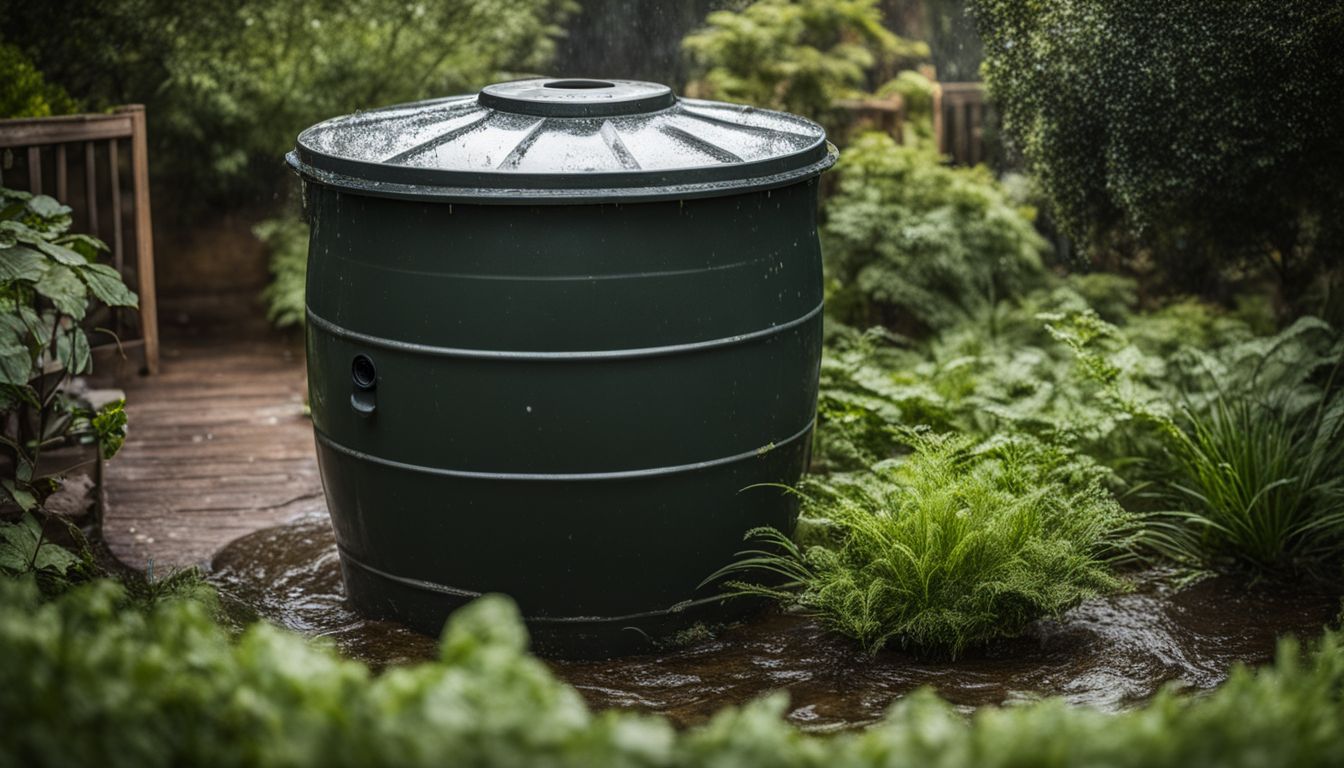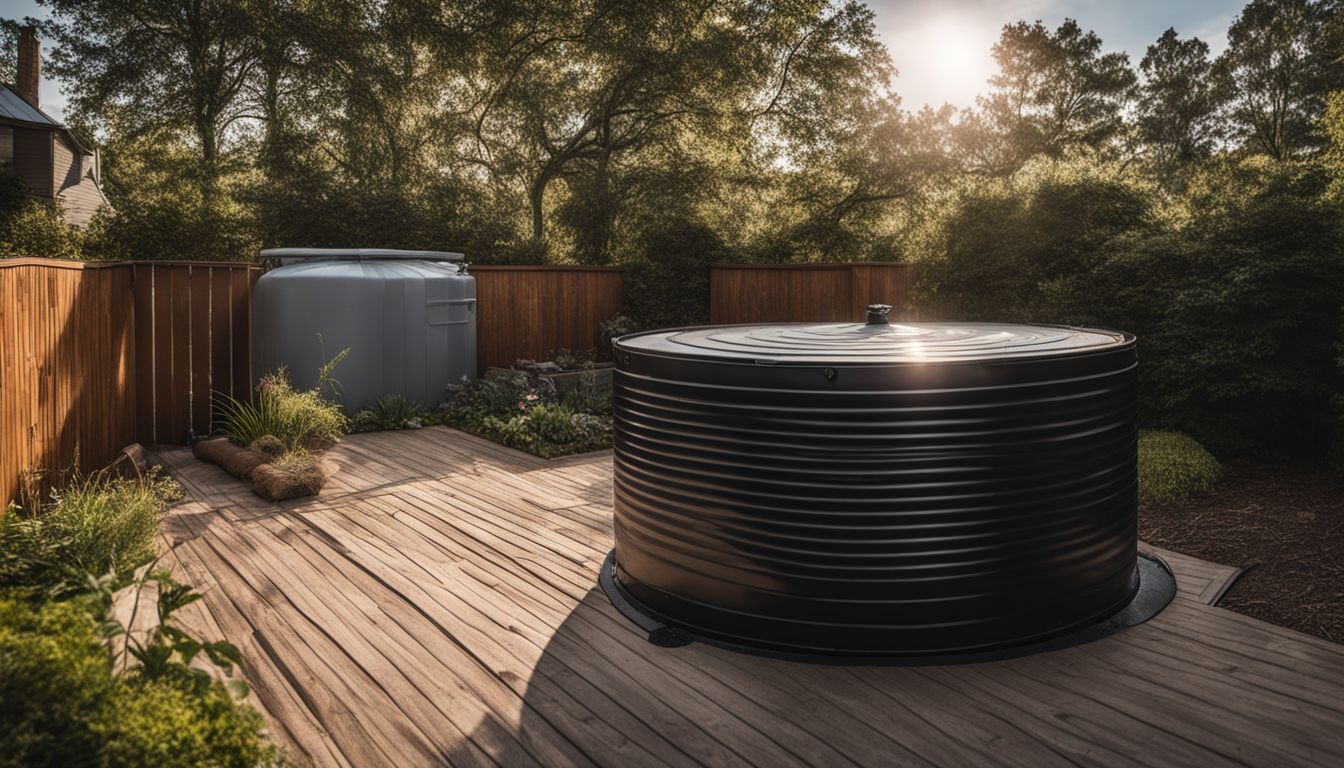
By: Alternative Habitat Blueprint
Efficient Rainwater Harvest System: Benefits of Rainwater Harvesting Systems for Stormwater Management
Rainwater harvesting isn’t just an age-old method; it’s a smart solution for today’s stormwater management challenges. At its core, this system captures rain from roofs and surfaces, storing it for future use.
This process not only provides a sustainable water source but also plays a crucial role in reducing runoff and erosion – key factors in managing stormwater effectively. Our exploration will reveal how integrating efficient rainwater harvesting systems can significantly benefit both households and communities.
With over two decades of experience in alternative housing design, including extensive work on eco-housing projects, our insights into rainwater collection are grounded in practical knowledge and passion for sustainability.
Our journey through designing innovative living spaces that respect nature has taught us the importance of embracing technologies like rain barrels and underground storage solutions to maximize water resources wisely.
Stick around – you’ll find valuable strategies ahead.
Key Takeaways
- Rainwater harvesting collects and stores rain, reducing runoff and erosion. This helps manage stormwater.
- Using harvested rain for tasks like watering gardens or flushing toilets cuts down on tap water use.
- Installing systems like rain barrels or underground tanks can prevent flooding and save money.
- These systems are good for the environment by lowering demand on city water and keeping rivers clean.
- Both homes and businesses can use collected rainwater, making communities more sustainable.
Understanding Rainwater Harvesting

Rainwater harvesting involves collecting and storing rainwater for various uses. It’s an essential method for conserving water resources and reducing reliance on mains water supply.
Definition and process
Capturing rainwater involves collecting it from surfaces like roofs and then storing it in tanks or barrels. This process, known as rainwater harvesting, turns the water we often see as a nuisance during storms into a valuable resource.
My years of working with eco-friendly designs taught me that this method is not only simple but also incredibly effective. First, gutters catch the rain as it falls onto your roof.
Then, a downspout filter removes leaves and other debris. Next, clean water flows into a storage tank where it’s kept until you need it.
Importance lies in how this collected rain can be used—for watering gardens, flushing toilets, or even for drinking after proper treatment. Systems can include basic setups like simple barrels under downspouts to more complex arrangements with large cisterns equipped with filtration systems to purify the water.
From my projects across various homes, I’ve seen firsthand how integrating sediment filters and ultraviolet disinfection makes stored rainwater safe for almost any use around the house.
Importance and uses of harvested rainwater
Moving from the basics, let’s talk about why harvesting rainwater matters and how you can use it. This process isn’t just for saving water; it also plays a crucial part in our daily lives.
Harvested rainwater is free from chemicals. This makes it perfect for outdoor tasks like watering gardens or washing cars. Inside the house, it’s great for flushing toilets and even doing laundry.
Rainwater is life’s tap that never runs dry.
In my years working on eco-housing, I’ve seen first-hand how collected rain can support entire homes. Some folks use it to bathe or as their main drinking supply after simple purification steps.
Imagine cutting down on your water bill and still having plenty of clean water for every need – that’s what rain collection systems offer. From filling up an irrigation tank to keeping your clothes clean without tapping into the city supply, harvested rain proves its weight in gold time and again.
Benefits of Rainwater Harvesting Systems

Rainwater harvesting systems manage stormwater efficiently. They are sustainable and environmentally friendly, maximizing water resources. Implementing rain barrels, “dry” and “wet” systems, or underground collection maximizes the benefits.
Stormwater management
Managing stormwater plays a crucial role in keeping our cities and neighborhoods safe and dry. By using rainwater harvesting systems, we can catch and store rainwater before it floods our streets.
I’ve seen firsthand how these systems make a big difference. In one project, an installed aquascape rainwater collection system helped a crowded urban area reduce flooding during heavy rains.
These systems work by collecting rainfall from rooftops or surfaces into tanks or barrels. The collected water can then be used for watering plants, refilling ponds, or even for household needs after proper treatment.
This way, less rainwater ends up on the ground at once, easing the pressure on drains and sewers. It’s smart design meets nature’s challenge head-on — showing us that with thoughtful planning, we tackle big issues like stormwater overflow effectively.
Sustainability and Environment-friendly
Rainwater harvesting contributes to sustainability and eco-friendliness by reducing the strain on municipal water sources. It also aids in stormwater management by lessening the impact of heavy rains on drainage systems, preventing flooding and erosion.
Utilizing rainwater for household tasks like washing cars or irrigating gardens promotes environmental conservation and reduces reliance on potable water.
Businesses increasingly use rainharvesting for sustainability goals, conserving water resources, lowering costs, and meeting regulatory requirements. This not only benefits the environment but also plays a crucial role in creating sustainable communities.
Practical actions such as installing rain barrels or underground collection systems enable households to actively participate in this eco-friendly initiative towards self-sufficiency for various purposes.
Water resource maximization
Moving on from the discussion of sustainability and environment-friendliness, let’s now delve into the crucial aspect of water resource maximization. Rainwater harvesting systems play a pivotal role in maximizing water resources by providing an alternative source for various water needs.
Businesses and households can utilize collected rainwater not only for outdoor applications like irrigation but also for essential indoor uses such as flushing toilets and washing clothes, thus enhancing self-sufficiency while reducing strain on conventional water supplies.
The implementation of efficient rain barrels, “dry” and “wet” systems, as well as underground rainwater collection systems significantly contributes to effective stormwater management while optimizing available rainwater resources.
Efficient Rainwater Harvest Systems
Efficient rainwater harvest systems include rain barrels, “dry” and “wet” systems, and underground rainwater collection systems. These systems maximize water resources, manage stormwater, and are sustainable and environmentally friendly.
Rain Barrels
Rain barrels are great for collecting and storing rainwater. They can be used for things like watering plants, washing cars, or even flushing toilets. RainHarvest Systems offers rain barrels as part of their water harvesting systems to help with stormwater management.
Businesses are also using rain barrels to reduce strain on the water supply and meet sustainability goals.
Let’s move on to understanding “Dry” and “Wet” Systems in rainwater harvesting.
“Dry” and “Wet” Systems
Dry and wet systems are essential for efficient rainwater harvesting. Dry systems involve larger storage volume and the collection pipe “drys” after each rain event by emptying directly into the top of the tank.
On the other hand, wet systems include locating collection pipes underground to connect multiple downspouts from different gutters. This ensures effective stormwater management and maximizes water resource utilization.
The dry system‘s ability to empty directly into the storage tank after rainfall is a crucial feature that promotes efficient water harvesting. Wet systems, on the other hand, utilize underground collection pipes connected to various downspouts, making them an ideal choice for comprehensive rainwater management in both residential and commercial applications.
These methods are not only sustainable but also environment-friendly, offering innovative solutions for managing stormwater effectively.
Entities:
Underground Rainwater Collection Systems
Transitioning from the discussion of “Dry” and “Wet” systems, let’s explore underground rainwater collection systems. These systems offer efficient storage solutions for harvested rainwater in residential and commercial applications.
With the ability to collect and store large quantities of rainwater, underground collection systems are effective for both external uses like irrigation and car washing, as well as internal activities such as flushing toilets and doing laundry.
Moreover, these systems contribute to sustainable water management while providing a secure water source that does not require chemical treatment.
Conclusion
Rainwater harvesting systems offer numerous benefits for stormwater management. They help reduce the strain on municipal water supply, provide a secure and dependable water source, and contribute to sustainability goals.
With components like collection surfaces, downspout filters, storage tanks, and pumps or gravity systems, rainwater can be utilized for various applications both indoors and outdoors.
The efficient rainwater harvest systems not only maximize water resources but also play a key role in environmentally friendly practices. By implementing these systems, households and businesses can actively contribute to sustainable water management while reaping the advantages of cost-effective and reliable rainwater utilization.